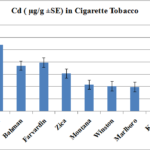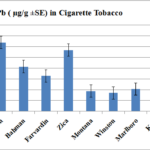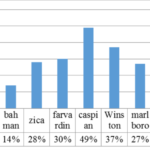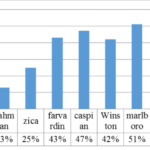J Med Discov (2017); 2(1):jmd16006; doi:10.24262/jmd.2.1.16006; Received October 25th, 2017, Revised March 20th, 2017, Accepted March 25th, 2017, Published March 30th, 2017.
Analysis of Heavy Metals in Cigarette Tobacco
Parisa Ziarati1,2,*, Zahra Mousavi3, Sanaz Pashapour3
1Young Researchers & elite Club, Pharmaceutical Sciences Branch, Islamic Azad University, (IAUPS) , Tehran, Iran
2Department of Medicinal Chemistry, Pharmacy Faculty, Pharmaceutical Sciences Branch, Islamic Azad University, (IAUPS), Tehran- Iran
3 Department of Pharmacology & Toxicology, Faculty of Pharmacy, Pharmaceutical Sciences Branch, Islamic Azad University, Tehran – Iran (IAUPS)
* Correspondence: Parisa Ziarati, Young Researchers & elite Club, Pharmaceutical Sciences Branch, Islamic Azad University, (IAUPS) , Tehran, Iran. Email: ziarati.p@iaups.ac.ir
Tel: +98-21-22600037; Fax: +98-21-22633986.
Abstract
It has been reported that tobacco plant easily takes up metals from soil and concentrated them in leaves. This contamination is different in each country in which the tobacco plant is harvested and processed. The main goal of this study was to determine whether local and imported cigarette brands used in Iran, have elevated heavy metals or not. The levels of lead and cadmium in ten popular cigarette brands sold and/or produced in Iran as smoked cigarette filter (after normal smoking by a single volunteer) and non-smoked cigarette filter and also their tobacco were determined by flame atomic absorption spectrophotometer by wet digestion method. The results indicated that the filter part and cigarette brands with lower level of cadmium in their tobacco parts had higher absorbing cadmium in their filter part after smoking (p < 0.05). The wild range of cadmium and lead were found even in the same brand according to producing dates. The percentage ranges of Cd and Pb absorbed and trapped by filter of different branded cigarette were found at 116-234% and 112-198% respectively. Cadmium and Lead concentration in tobacco of most of studied local brand cigarette was higher as compared to concentration of Cd and Pb observed in popular foreign brands. Our results also revealed that the heavy metals content in ash tobacco leaves were lower compared to that of selected cigarette and Cadmium and lead contents in studied cigarettes and tobacco leaves were found to be below the world standards for human consumption by plant uptake.
Keywords: Tobacco Cigarette, Environmental Contamination, Heavy Metals, lead, cadmium.
Introduction
Plants are amenable to absorb and accumulate heavy metals from the soil into their leaves. The factors governing heavy metals speciation, adsorption and distribution in soil are pH, soluble organic matter content and soil type, presence of organic and other metal ion(1,2) Several heavy metals found in tobacco smoke such as Cadmium, Chrome, Lead and Nickel also accumulate in tissues and fluids through smoking (3-9) . Elinder et al., in 1983 and Galazyn -Sidorezuk et al., in 2008 (10, 11), reported that tobacco plant easily take up metals from soil and concentrated them in leaves. This contamination is different in each country in which the tobacco plant is harvested and processed. Thus tobacco and cigarettes can generally accumulate metals such as Pb, Cd, Zn, Ni and Cu preferentially (12-19).
More studies by Ebisike et al (20), Barlas et al (21), Yang et al (22), Verma et al (23) and Schneider and Krivan (24) showed high levels of toxic elements in cigarettes tobacco. Studies have shown that, each year about 3000 non-smoking adults’ die of lung cancer as a result of breathing the second-hand smoke from other’s cigarette (25, 26). Rodgman and Perfetti Rodgman reported that cigarettes smoke has 7357 chemical compounds and many were environmental contamination problems (27). It has been reported that a great number of people have become victims of environmental tobacco smoke (ETS) as they participate passively. Factors that have impact on smoking habits of cigarette includes: the presence of additive compounds like nicotine, mass production, social acceptance, light weight, availability and relative cheapness (2, 26).
Although the heavy metals in cigarettes and mainstream smoke have been extensively researched, few studies have attempted to identify and quantify the main reason of its toxicity, Micevska et al in 2006 suggest that the toxicity of cigarette butt leaches is in part due to heavy and trace metals (28). The occurrence of metals in cigarette can be attributed to the growth and cultivation of tobacco, soil contamination, pesticide and herbicide application, cigarette manufacturing process and the use of brightening agents on the wrapping paper (29, 30, 31, 32).
The consumption of tobacco products and the number of smokers have been increasing in Iran. In an earlier report it was revealed that the overall prevalence of self-reported cigarette smoking was 14.3% (33). The presence of Pb and Cd is highly varied in different cigarette brands (9, 34). The main goal of this study was to determine whether local and imported cigarette brands used in Iran, have elevated heavy metals or not, therefore the levels of lead and cadmium in ten popular cigarette brands sold and/or produced in Iran as smoked and non-smoked cigarette tobacco were determined.
Materials and Methods
Collection of Samples
Ten popular cigarette brands sold and/or produced in Iran as were purchased from local market in Tehran, Iran. For collection of pre-smoking components, cigarettes were separated into tobacco and filter. Post-smoking components were also collected after normal smoking by a single volunteer and prepared for analysis. Cigarette smoking was carried out till the burning line reached the butt length (different according to different brands). Care was taken to avoid any source of contamination, and this preparation was conducted in a clean room. The remainder of the smoked cigarette was separated into a used filter and a tobacco butt. Tobacco and filter parts (in two states of smoking and not smoking) were analyzed separately at the same time.
Heavy metals Determination
The samples were dried in an oven at a temperature of 80°C for 12 h and allowed to cool in a desecrator. One gram of the tobacco sample was weighed precisely on an electronic balance (Bosch D.7455). For analysis of Cd and Pb, the samples were separately put in a 100 ml digestion flasks to which 10 ml of digestion mixture was added and heated on a hot plate in the fuming chamber for wet digestion with a digestion mixture comprising of concentrated HNO3 and HClO4 at the ratio of 3:1(35-42). All glassware and plastic containers used were washed with liquid soap, rinsed with water, soaked in 10% volume/volume nitric acid at least overnight, and rinsed abundantly in deionized water and dried in such a manner to ensure that any contamination does not occur. Five-point calibration curves (five standards and one blank) were constructed for each analyte. The calibration curve correlation coefficient was examined to ensure an r2 ≥ 0.998 before the start of the sample analysis.
Standardized international protocols were followed for preparation of the materials and analysis of heavy metals (Pb, Cd) contents. The samples were analyzed by a Flame Emission Spectrophotometer Model AA-6200 (Shimadzu, Japan), using an air acetylene flame and at least four standard solutions for each heavy metal (Pb, Cd). Coefficient of variations (%CV) in the determination of the heavy metals in all samples was less than 2.5%. All necessary precautions were taken into account to avoid any possible contamination of the samples as per the AOAC guidelines. Quantification was achieved by interpolating the relevant calibration curves prepared from aqueous solutions of metal standards in the same acid concentration, in order to minimize matrix effects.
Statistical methods
State differences on the basis of the states: Smoking and not smoking filter samples and their tobacco were determined by student t-test. The changes were calculated by one way Anova and for analysis of the role of multiple factors univariate analysis was used by SPSS 18. Probability values of <0.05 were considered significant.
Results
Results were determined as mean ± SE of dry weight from three replicates in each test. The samples were analyzed by wet digestion method and standardized international protocols were followed for the preparation of material and analysis of heavy metals contents and analyzed by Atomic Absorption Spectrophotometer in Research Laboratory in Pharmaceutical Sciences Branch, Islamic Azad University. Results obtained using AAS technique for determination of heavy metals in Tobacco and filter parts (in two states of smoking and not smoking). The mean values of cadmium and lead (µg/g ± SE) in cigarette tobacco samples are shown in figure 1 and 2 respectively. Cadmium content in tobacco of Caspian brand was 5.40 ± 0.0034 in the highest level and in Kent brand cadmium had the lowest level 1.82 ± 0.0064 (µg/g ± SE). There was a positive correlation between the cadmium content in tobacco cigarette. The filter part and cigarette brands with lower level of cadmium in their tobacco parts had higher absorbing cadmium in their filter part after smoking (p < 0.05).
Figure 1. The mean content of Cadmium ( µg/g ± SE) in tobacco parts of studied cigarettes.
Figure 2. The mean content of Lead (µg/g ± SE) in tobacco parts of studied cigarettes.
Lead and Cadmium detected in all cigarette filters before and after smoking in wide range of concentrations. The percent of increasing of Cadmium and lead in smoked samples in comparison by non-smoked cigarette filters tested are presented in Figure 3 and 4 respectively. The average concentration of Cd and Pb in Iranian cigarettes filter tested is 0.6 mg/kg and 34.44 mg/kg respectively. The Kent cigarette filter had highest percent increase of Cadmium by smoking (234%) while Bahman had lowest percent increase of Cadmium (116%). The Caspian cigarette filter had highest percent increase of Lead by smoking (198%), while Montana had lowest percent increase of Lead (112%). Thus, these data suggest cigarette litter was found to be a point source for metal contamination.
Figure 3. The mean percentage of absorbing Lead by filter parts of studied cigarette samples after smoking
Figure 4. The mean percentage of absorbing Cadmium by filter parts of studied cigarette samples after smoking
Discussion
In present study Cadmium and Lead concentration was measured in cigarette filters and tobacco parts of popular Iranian or imported brands which are available in Tehran-Iran market. The results indicated that the understudy analytes were detected in filter before smoking, also were increased in it after smoking .The wild range of cadmium and lead were found even in the same brand according to producing dates. The percentage ranges of Cd and Pb absorbed and trapped by filter of different branded cigarette were found at 116-234% and 112-198% respectively. Cadmium and Lead concentration in tobacco of most of studied local brand cigarette was higher as compared to concentration of Cd and Pb observed in popular foreign brands. Since there was no sufficient data about heavy metals contents in Iranian cigarette brands, this study could provide a new data to be useful for health organizations in Iran.
The amount of these toxic metals absorbed and trapped by filter of different branded cigarette were different and plays an important role in terms of toxic metals distribution environmental pollution.
Conclusion
In present study, the findings represent that the Cd and Pb contents in studied cigarettes and tobacco leaves were found to be below the WHO and international standards for human consumption by plant uptake. Our results also revealed that the heavy metals content in ash tobacco leaves were lower compared to that of selected cigarette. Further study is required to determine the mobility of metals in tobacco leaves and filter cigarette under different conditions.
Competing interests
The authors declare that they have no competing interests.
Acknowledgments
Financial Supports from Pharmaceutical Sciences Branch, Islamic Azad University (IAUPS) is gratefully acknowledged.
References
1. Noler, B.N.; Mayes, T.L.; Raite, U.Y,; Sail, S.S. African Journal of Biotechnology .2006, 8 , 67-77.
2. Eneji, I. S.; Salawu, O.W.; Sha’Ato, R. Journal of Science (JOS). 2013, 244 (3), 1.
3. Galazyn-Sidorczuk, M.; Brzóska, M. M. ; Moniuszko-Jakoniuk, J. Environmental Monitoring and Assessment. 2008, 137(1–3), 481–493.
4. Erzen, I.; Kragelj, L. Z. Bulletin of Environmental Contamination and Toxicology. 2006, 76, 278–284.
5. Al-Bader, A.; Omu, A. E.; Dashti, H. Archives of Andrology, 1999, 43(2), 135–140.
6. Rey, M.; Turcotte, F.; Lapointe, C.; Dewailly, E. Journal of Toxicology and Environmental Health Part A, 1997, 51(1), 5–14.
7. Shaham, J.; Meltzer, A.; Ashkenazi, R.; Ribak, J. Journal of Occupational and Environmental Medicine, 1996, 38(12), 1220–1228.
8. Paakko, S.; Anttila, P. ; Kalliomaki, L. Environmental Research, 1989, 49(2), 197–207.
9. Ashraf, M. W. P. The Scientific World Journal. 2012,Article ID 729430. Available in site: http://dx.doi.org/10.1100/2012/729430.
10. Article ID 729430. Available in site: http://dx.doi.org/10.1100/2012/729430.
11. Elinder, C.G.; Kjellstrom, T.; Lind, B.; Linnman, I.; Piscator, M.; Sundstedt, K. Environ. Res. 1983, 32, 220-227.
12. Galażyn-Sidorczuk, M.; Brzóska, M.M.; Moniuszko-Jakoniuk J. Environ. Monit. Assess . 2008, 137,481–493.
13. Watanabe, T.; Kasahara, M.;Nakatsuka, H.; Ikeda, M. Sci. Total. Environ. 1987, 66,29–37.
14. Massadeh, A.M.; Alali Feras, Q.; Jaradat-Qasem, M. Environ. Monitor Assess. 2005,104,163–170.
15. Kelishadi, R.; Ardalan, G. CASPIAN study. Preventive medicine. 2006,42(6),423-426.
16. Kazi, T.,; Jalbani, N. Journal of hazardous materials . 2009, 163(1), 302-307.
17. Elinder, O. Journal of Botany, 2010, 10 , 230.
18. Watanabe, T.; Kasahara, M. Science of the total environment. 1987, 66, 29-37.
19. Saldivar, L.; Luna, M; Reyes, E.; Soto, R.; Fortoul, T.I. Environ. Res. 1991, 55, 91-96.
20. Pourkhabbaz, A.; Pourkhabbaz, H.R.. Iranian Journal of Basic Medical Sciences. 2012, 15, ( 1), 636-644.
21. Ebisike, K.; Ayejuyo, O.O.; Sonibare, J.A.; Ogunkunle, O.A.; Ojumu, T.V. J. Appl. Sci. 2004, 4,623-629.
22. Barlas, H.; Ubay, G.; Soyhan, B.; Bayat, C. Fresenius Environ. Bul. 2001,10, 80-83.
23. Yang, G.; Li, Z.; Shi, H.; Wang, J. J. Anal.Chem. 2005, 60, 480-485.
24. Verma, S.;Yadav-Singh, I. Food Chem. Toxicol. 2010,doi: 10.1016/j.fct.2010.05.062.
25. Schneider, G.; Krivan, V. Int. J. Environ. Anal. Chem. 1993, 53, 87-100.
26. Hynes, D.R. Environmental Pollution. 2007 , 9, 211-221.
27. Zhang,V.B; Xenon, F.O.; Flow, A.A. Pakistan research journal. 2005, 132, 144-160.
28. Rodgman, P.; Perfetti-Rodgman, P.P ; Perfetti, O.L. Journal of Plants Nutrition. 2009, 6 (5), 45-55.
29. Micevska, T.; Warne, M. S. J. Archives of environmental contamination and toxicology, 2006, 50(2), 205-212.
30. Owens, J.r. W. F. Recent Advances in Tobacco Science.1978, 4, 3-24.
31. Tso, T. C. Production, physiology, and biochemistry of tobacco plant.1990.
32. Chiba, M.; Masironi, R. Bulletin of the World Health Organization.1992, 70(2),269.
33. Mavrikou, S.; Flampouri, K. Sensors. 2008, 8(4), 2818-2832.
34. Kelishadi, R.; Ardalan, G.; Gheiratmand, R.; Majdzadeh, R.; Delavari, A.; Heshmat, R.; Mokhtari, R.M.; Razaghi, M.; Motaghian, E.M.; Ahangar-Nazari, I. CASPIAN study. Preventive medicine. 2006, 42,423-426.Kazi, T.; Jalbani, N.;
35. Kazi, T.; Jalbani, N.; Arain, M.; Jamali, M.; Afridi, H.; Sarfraz, R.; Shah, A. Journal of hazardous materials .2009, 163, 302-307.
36. Ziarati, P.; Khoshhal, Z.; Asgarpanah, J.; Qomi, M. Intl J Farm & Alli Sci. 2013, 2 , 383-387.
37. Ziarati, P.;Ziarati, N.N.;Nazeri,S. Saber-Germi, M. Oriental Journal of Chemistry. 2015, 31(1). Available from: http://www.orientjchem.org/?p=7693.
38. Mirmohammad-Makki, F.; Ziarati, P. BIOSCIENCES BIOTECHNOLOGY RESEARCH ASIA .2014, 11(2), 537-544.
39. Ziarati, P.; Tosifi, S. IJPAES. 2014 , 4(2), 519-528.
40. Ziarati, P.; Azizi, N. Intl. J. Farm & Alli. Sci. 2013, 2 , 1203-1209 .
41. AOAC . Association of Official Analytical Chemists. Wet digestion for non –volatile metals in: AOAC official methods of analysis , 1998,16th edition, 4th revision, vol.1,chapter 9.
42. Ziarati, P. J. Environ. Analytic Toxicol. 2012, 2, 120.Doi:10.4172/2161-0525.1000120.
43. Mohammadi, S.; Ziarati,P. Oriental Journal of Chemistry. 2015, 31 (1). Available from: http://orientjchem.org/?p=7825
Copyright
© This work is licensed under a Creative Commons Attribution 4.0 International License. The images or other third party material in this article are included in the article’s Creative Commons license, unless indicated otherwise in the credit line; if the material is not included under the Creative Commons license, users will need to obtain permission from the license holder to reproduce the material. To view a copy of this license, visit http://creativecommons.org/licenses/by/4.0/






